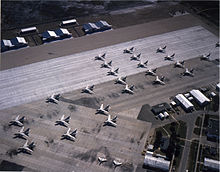Naval Air Station Sanford
Opening less than a year after the start of World War II, NAS Sanford's initial function was as an advanced training base for land-based patrol bombers, followed by carrier-based fighter aircraft.
The base initially concentrated on advanced land-based patrol plane training, operating PV-1 Venturas, PBO Hudsons and SNB-2 Kansans.
Peak wartime complement during 1943–1945 reached approximately 360 officers and 1400 enlisted men, both Navy and Marine Corps, with an additional complement of Naval Reserve officer and enlisted WAVES (Women Accepted for Volunteer Emergency Service) who served in air traffic control, meteorological services, administrative support, and aircraft maintenance.
Subsequently, redesignated as a full naval air station and renamed NAS Sanford once again, the installation initially served as a home station for carrier-based F9F Panther,[5] and F2H Banshee fighter aircraft,[5] and AD Skyraider and AJ Savage attack aircraft in squadrons assigned to the U.S. Atlantic Fleet.
[6] The upgrades to the former NAAS to achieve status as a full-fledged NAS and Master Jet Base included lengthening of the main runway to 8,000 feet (2,400 m) with additional overruns of approximately 2,000 feet (610 m) on both ends; construction of additional new hangars; barracks and administrative support buildings for the air station, heavy attack wing, heavy attack squadrons, and Marine Barracks; installation or upgrades to precision approach radar/ground controlled approach (PAR/GCA), non-directional beacon (NDB) and tactical air navigation (TACAN) navigational aids; a robust storage and distribution system for JP-5 jet fuel (which relied on resupply via a railroad spur into the base); secure weapon/air-dropped ordnance storage facilities; a Navy Dispensary; a Navy Exchange complex and associated garage/service station/MiniMart; and morale, welfare and recreation (MWR) facilities that included a base movie theater, two swimming pools, lakeside recreational facilities and separate clubs for officers, chief petty officer and enlisted personnel pay grade E-6 and below.
Like Pinecastle AFB (later renamed McCoy AFB), a Strategic Air Command installation approximately 25 miles (40 km) to the south, a commissary and full-fledged Naval Hospital facilities were not considered necessary at NAS Sanford due to the relatively close proximity of a commissary and USAF Hospital at Central Florida's other major military installation at the time, the nearby Orlando AFB (which was transferred to the U.S. Navy's control in December 1968 and renamed Naval Training Center Orlando), approximately 12 miles (19 km) to the south.
However, OLF Osceola's 4000 to 5,000-foot (1,500 m) runways lacked sufficient length and pavement strength for contemporary carrier-based jet aircraft like the A3D.
[2] Due to the Skywarrior's nuclear strike mission and the presence of an associated special weapons storage area at NAS Sanford, U.S. Marine Corps personnel provided both base security and special weapons storage area security, leading to the establishment of Marine Corps Barracks Sanford aboard the air station.
Unfortunately, only a few months later, Congress directed the closure of NAS Sanford in 1968 due to funding constraints caused by the Vietnam War and President Lyndon Johnson's concurrent Great Society programs that necessitated the closure or realignment of several stateside air force bases and naval air stations as Department of Defense economy measures.
With the later post-Vietnam closure of NAS Albany in 1975, RECONATKWING ONE and its squadrons subsequently relocated again, this time to NAS Key West, Florida, during the 1974–75 time frame and continued to deploy to both the Atlantic, Mediterranean and Pacific aboard Forrestal, Kitty Hawk, Enterprise and Nimitz-class aircraft carriers.






